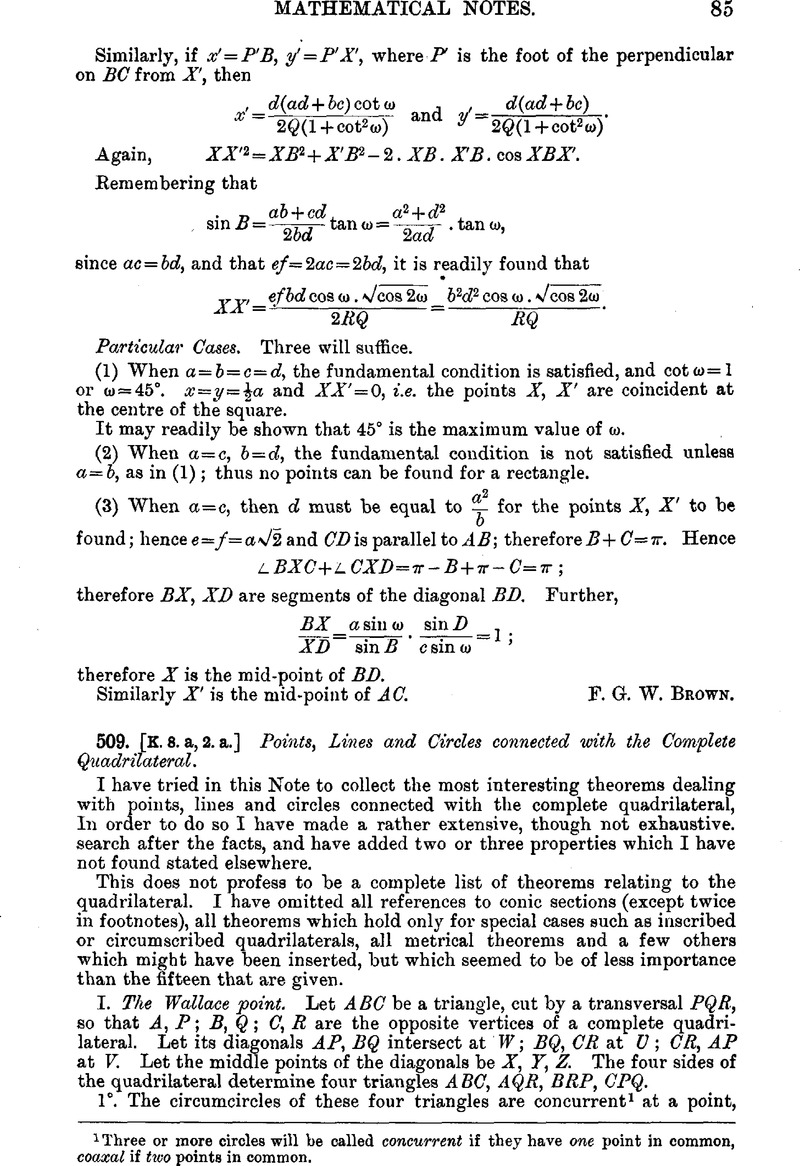Article contents
509. [K. 8. a, 2. a.] Points, Lines and Circles connected with the Complete Quadrilateral.
Published online by Cambridge University Press: 03 November 2016
Abstract

- Type
- Mathematical Notes
- Information
- Copyright
- Copyright © Mathematical Association 1917
References
page note 85 1 Three or more circles will be called concurrent if they have one point in common, coaxal if two points in common.
page note 86 1 This theorem was first stated by “Scoticus,” probably a pseudonym for Dr. William Wallace (Mackay, Proc. Edin. Math. Soc., 9, 1890-91), in 1804, in Leybourn’s Math. Repos., vol. 1, part 1, p. 170. It was restated by Steiner in 1828 as the first of ten theorems proposed for solution in Gergonne’s Annales, vol. 18.
page note 86 2 Casey, Analytical Geometry, p. 535, Ex. 81. It is easily proved by pure geometry.
page note 86 3 Carles states that L 1, L 2, U, Y, Z are concyclic (Jour, de Math, élém., 1883).
page note 86 4 In fact they concur at the Wallace point of the quadrilateral UX, VY, WZ. Cf.7°.
page note 86 5 This is the second of Steiner’s theorems (Gergonne’s Annales, vol. 18, 1828). It was restated in 1835 by T. S. Davies of Bath, and proved by him in Leybourn’s Mathematical Repository, Q. 555, vol. 6. Probably Davies discovered the theorem independently of Steiner; that Davies had been studying the quadrilateral for some time is evidenced by his statement in connection with the solution of Q. 524 in the Repository, and by Mackay’s remark (Proc. Edin. Math. Soc., vol. 9. 1890-91) that Davies had proposed a question in 1821 in the Leeds Correspondent dealing with a property of this figure. At any rate he published the first proof of the theorem. After proving the theorem, Davies proceeds with several other properties of a quadrilateral, including a special case of 5°.
page note 86 6 Hermes, Nouv. Annales de Math., 1859, Q. 476. Solved, p. 359.
page note 87 1 Hermes calls this circle the eight-point circle (loc. cit.). Gallatly calls it the centre circle (Mod. Geom. of Tri., p. 5).
page note 87 2 J. T. Connor proved in 1795, in the Ladies’ Diary, that the middle points of the diagonals of the complete quadrilateral are collinear. This was Steiner’s third theorem (Gergonne, loc. cit.). Steiner attributed the theorem to Newton, but there is no evidence that it was known prior to 1795. 7° was stated in the Repository, Q. 555, by Davies, and again in the same number as Q. 600 by Twaddleton.
page note 87 3 The polar circle of a triangle is a circle, having the orthocentre for centre, and with respect to which the triangle is self-conjugate. The circle is imaginary unless the triangle is obtuse angled.
page note 87 4 Steiner stated that the orthocentres of the four triangles are collinear on a line perpendicular to the mid-diagonal line (Gergonne, loc. cit.). Davies proved the fact in the Repository (loc. cit.). The earliest reference I have found to the complete theorem 8° is in a paper by Mention, to be referred to later (Nouv. Annales de Math., vol. 1, p. 16), where its truth is taken, for granted as if it were well known. For a proof see Durell, Plane Geometry for Advanced Students, part 1, Theorem 86, p. 188 (1909).
It is well known that the parabola which touches the four sides of the quadrilateral has O for its focus, and the orthocentric line for its directrix.
page note 87 5 See Gallatly, Mod. Geom. of Triangle, Chap. VI.
page note 87 6 The mean centres of the vertices of the quadrilaterals BCQR, CARP, ABPQ also lie on the mid-diagonal line. One of the parabolas determined by the centroids of the four triangles ABC, AQR, BRP, CPQ has its axis parallel to the mid-diagonal line, and is so placed that the Wallace point is two-thirds as far from the mid-diagonal line as from the axis.
page note 87 7 This is due to Steiner (Gergonne, loc. cit.); proofs were first given by Davies (Repos., Q. 555, loc. cit.).
page note 87 8 Catalan, Théorèmes et Problèmes, 6th edit., p. 34.
page note 87 9 The Lady’s and Gentleman’s Diary, 1864, p. 55.
page note 88 1 Casey, Sequel to Euclid, p. 164, Ex. 138 (1886).
page note 88 2 This beautiful and surprising theorem is the last and best of Steiner’s theorems (Gergonne, loc. cit.). Like his other theorems on the quadrilateral, it was never proved in the Annales, which ceased publication in 1831. In 1862, Mention (Nouv. Annales de Math., vol. 1, 1862, pp. 16 and 65), making use of several new theorems, gave an elaborate proof of 13°. As Mention points out, it is probable that Steiner possessed a simpler proof which he never published.
page note 88 3 Mention, Nouv. Annales, 1862, p. 16.
page note 88 4 Sancery, Nouv. Annales, vol. 14, p. 145, 1875.
page note 88 5 Modern Pure Geometry, Preface, edit, of 1893.
- 2
- Cited by


